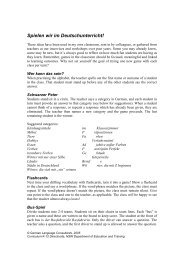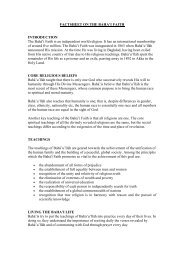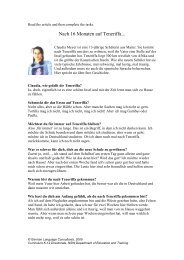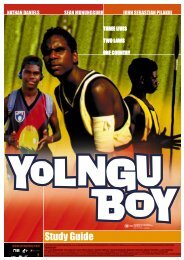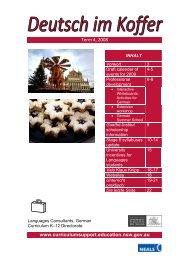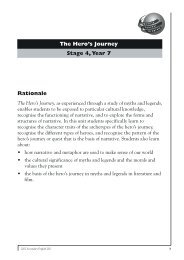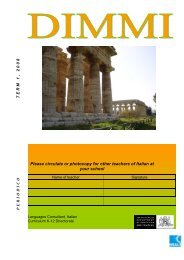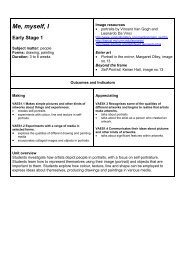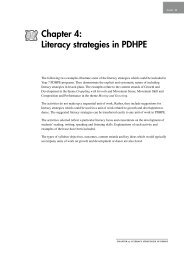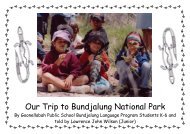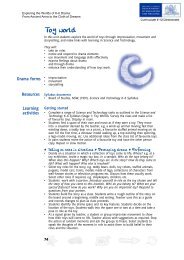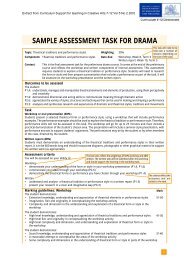Mabo Study Guide - Curriculum Support
Mabo Study Guide - Curriculum Support
Mabo Study Guide - Curriculum Support
Create successful ePaper yourself
Turn your PDF publications into a flip-book with our unique Google optimized e-Paper software.
0<br />
S T U D Y G U I D E
<strong>Mabo</strong> – Life of an Island Man traces the<br />
story of the life of an extraordinary man,<br />
Eddie Koiki <strong>Mabo</strong>. His struggle for land<br />
rights, and his remarkable life in general,<br />
have had a profound effect on indigenous<br />
rights in Australia. The film is a celebration<br />
of his achievements. It highlights how<br />
<strong>Mabo</strong> pursued the case to have his<br />
ownership of property on Mer (Murray<br />
Island) legally recognised, and how that<br />
claim grew into a case that changed<br />
indigenous rights in Australia.<br />
Eddie Koiki <strong>Mabo</strong> was born on Murray Island in the Torres<br />
Strait, but lived most of his life in exile on mainland Australia.<br />
Only after his death did the island wholeheartedly welcome him<br />
home. By then the island and Eddie <strong>Mabo</strong> had changed the<br />
legal and political landscape of Australia.<br />
On June 3, 1992, five months after Eddie <strong>Mabo</strong> died tragically of cancer aged 55, the High Court of Australia upheld his<br />
claim that Murray Islanders held ‘Native Title’ to three islands on the eastern fringe of the Torres Strait. This ended the<br />
theory of terra nullius, or land belonging to no one at the time of white settlement. Aboriginal and Torres Strait Islander<br />
communities across Australia greeted what became known as ‘The <strong>Mabo</strong> Judgement’ with jubilation. The legal fiction that<br />
Australia was an ‘empty land’ when first occupied by white people was laid to rest by the highest court in the land. After<br />
more than 200 years, European law had to recognise pre–existing indigenous law.<br />
The world knows little about Eddie <strong>Mabo</strong> and his life.<br />
Filmmaker Trevor Graham was a friend of Eddie <strong>Mabo</strong>’s during<br />
the last years of his life. Graham’s film, <strong>Mabo</strong> – Life of an<br />
Island Man, tells the story of Eddie <strong>Mabo</strong>’s public and private<br />
life and helps all who see it to understand the struggle he went<br />
through to achieve recognition of indigenous law and<br />
traditions.<br />
The film includes part of Graham’s earlier production Land<br />
Bilong Islanders (1989), which is the only film record of the<br />
<strong>Mabo</strong> legal proceeding. Trevor Graham describes an important<br />
motive behind the film:<br />
The real reason for wanting to make the film was [my] being<br />
absolutely horrified and devastated when his [Eddie <strong>Mabo</strong>’s]<br />
grave was desecrated. I fell into a crumbling heap. The<br />
morning after <strong>Mabo</strong>’s funeral, his headstone was vandalised.<br />
Red swastikas were painted on it and a sculptured image of<br />
<strong>Mabo</strong>’s face was hacked off. Chronicling this event and its<br />
aftermath takes up about a quarter of the film.<br />
<strong>Mabo</strong> – Life of an Island Man shows us the devastating<br />
consequences and impact of racism, which did not even allow<br />
Eddie <strong>Mabo</strong> a peaceful resting place until his body was taken<br />
home to the island of Mer.<br />
The film is a stirring and true testament of what one man, and<br />
his family, can accomplish.<br />
2
<strong>Curriculum</strong> focus:<br />
<strong>Mabo</strong> – Life of an Island Man will have relevance for<br />
teachers and students of Aboriginal education/Aboriginal<br />
studies, Studies of Society and Environment (or HSIE),<br />
Religion and Society, History, Legal Studies, and English.<br />
It can be appreciated by students from upper primary<br />
school to senior secondary. It is a film which should be<br />
seen and understood by all Australians.<br />
Before Watching the Film<br />
Students and teachers should be sure that they know the<br />
answers to this question:<br />
Who are Australia’s indigenous people?<br />
‘An Aboriginal or Torres Strait Islander person is a person<br />
of Aboriginal or Torres Strait Islander descent who<br />
identifies as Aboriginal or Torres Strait Islander and is<br />
accepted by the community with which he or she is<br />
associated.’<br />
Commonwealth of Australia<br />
‘The Commonwealth definition is social rather than racial,<br />
in keeping with the changes in Australian attitudes away<br />
from racialistic thinking about other peoples. An<br />
Aboriginal person is defined as a person who is a<br />
descendant of an indigenous inhabitant of Australia,<br />
identifies as an Aboriginal, and is recognised as Aboriginal<br />
by members of the community in which he or she lives.<br />
‘This definition is preferred by the vast majority of our<br />
people over the racial definitions of the assimilation era.<br />
Administration of the definition, at least by the<br />
Commonwealth for the purposes of providing grants or<br />
loans, requires that an applicant present a certificate of<br />
Aboriginality issued by an incorporated Aboriginal body<br />
under its common seal…<br />
‘Our people, of course, did not use the word ‘Aborigine’<br />
(from the Latin aborigine – ‘from the beginning’) to refer<br />
to ourselves before the coming of non-Aborigines.<br />
Everyone was simply a person and each language had its<br />
own word for “person”… After 1770, words for “person”<br />
such as Yolngu, Yapa, Koori, Murri etc, were used to refer<br />
to Aborginal people only, excluding the newcomers. Many<br />
of these words are used today by English speakers. There<br />
have been some attempts to find an indigenous generic<br />
term which could replace Aborigine in English, however<br />
some of these words get used outside their area of origin<br />
in reference to people who use their own words and they<br />
may take offence. Aboriginal and Torres Strait Islanders<br />
also find it offensive to be referred to by the acronym<br />
ATSI and prefer that the words be used in full.’<br />
Source: The Little Red, Yellow and Black (and green and<br />
blue and white) Book: A Short <strong>Guide</strong> to Indigenous<br />
Australia, AIATSIS (1994).<br />
Historical Background to Develop<br />
Understandings:<br />
In 1770 Captain Cook claimed eastern Australia in the<br />
name of the Kind of England as terra nullius – ‘land<br />
belonging to no one’. This meant that under British law<br />
23<br />
all the land of Australia became Crown land. Aboriginal<br />
property rights were ignored. All the land belonged to the<br />
Crown or to whomever the Crown granted or sold it to.<br />
Eddie <strong>Mabo</strong>’s ancestors lived for centuries on a group of<br />
three islands in the Torres Strait, near Cape York. The<br />
islands, known as the Murray Islands, were annexed by<br />
the Queensland Government in 1879 and thus they<br />
became part of Australia. Queensland became responsible<br />
for their administration but despite this annexation, and<br />
the presence of European missionaries on the islands, the<br />
indigenous people permanently and continuously<br />
inhabited them – with very little change to their way of<br />
life as a result of the annexation. They continued to live<br />
in their settled communities; they maintained their<br />
traditional beliefs and customs; there was a clear way of<br />
passing on their garden plots of land, and ways of<br />
settling disputes about legal matters.<br />
In 1981, the first Aboriginal Senator Neville Bonner<br />
successfully moved this motion in Parliament in the<br />
Senate:<br />
That the Senate accepts the fact that the indigenous<br />
people of Australia, now known as Aborigines and<br />
Torres Strait Islanders, were in possession of the entire<br />
nation prior to the 1788 first fleet landing in Botany<br />
Bay, urges the Australian government to recognise prior<br />
ownership of the said indigenous people, and to<br />
introduce legislation to compensate the (indigenous)<br />
people for the dispossession of their land.<br />
But no such legislation was ever enacted.<br />
In the late 1970s, the Queensland Government attempted<br />
to dispossess some of the local inhabitants of their land.<br />
In 1982, five residents of the island of Mer, led by Eddie<br />
<strong>Mabo</strong>, began a court claim against the Queensland<br />
Government.<br />
They claimed that their rights to the land had not been<br />
extinguished by the Crown when their islands were taken<br />
over or annexed by Queensland. They still had a legal<br />
right to the land based on the legal concept of ‘native<br />
title’ – right of ownership based on traditional ownership<br />
of the land.<br />
The Queensland Government’s response was to pass the<br />
Coast Islands Declaratory Act, 1985. This claimed that:<br />
All rights to the land went to the Crown on the 1879<br />
annexation – that native title had been extinguished,<br />
and that no compensation for loss of land would be<br />
due to the Meriam people.<br />
In 1992, the High Court of Australia ruled that the 1985<br />
Queensland Act was invalid because it was contrary to the<br />
Commonwealth Racial Discrimination Act, 1975 which<br />
made it:<br />
... unlawful for any person to do any act involving a<br />
distinction based on race which has the effect of<br />
impairing the enjoyment of any human right or<br />
fundamental freedom. (<strong>Mabo</strong> Discussion Paper,<br />
Commonwealth of Australia, June 1993)<br />
The <strong>Mabo</strong> Discussion Paper summarises the High Court<br />
decision thus:
The High Court of Australia decided in <strong>Mabo</strong> v.<br />
Queensland that the Meriam people were entitled as<br />
against the rest of the world to the possession,<br />
occupation, use and enjoyment of (most of) the land of<br />
the Murray Islands in the Torres Strait. In reaching this<br />
conclusion a majority of the Court held that the<br />
common law of Australia recognises a form of native<br />
title: where those people have maintained their<br />
connection with the land; and where the title has not<br />
been extinguished by acts of Imperial, Colonial, State,<br />
Territory or Commonwealth governments.<br />
In 1996 the High Court delivered its judgement on the Wik<br />
case. The Commonwealth’s proposed amendments to the<br />
Native Title Act are being re-examined in the light of the<br />
Wik decision. There are important implications of the Wik<br />
decision for governments, pastoralists, mining and<br />
resource industries, Indigenous people and the whole<br />
Australian community.<br />
What is native title?<br />
‘Native title’ is the term used by Australia’s High Court to<br />
describe the common law rights and interests of Aboriginal<br />
and Torres Strait Islander peoples in land according to<br />
their traditions, laws and customs.<br />
The High Court <strong>Mabo</strong> decision in 1992 reversed the long<br />
standing legal fiction that the continent was terra nullius,<br />
and so for the first time, the common law rights in land of<br />
Australia’s Indigenous peoples were recognised.<br />
The common law, originally founded on custom and<br />
tradition, is the British system of judge-made law, based<br />
on precedent. It is over 800 years old. Native title is not a<br />
new type of land grant, but a common law right that predates<br />
the European settlement of Australia.<br />
Who has native title?<br />
Native title may be held by Aboriginal and Torres Strait<br />
Islander peoples who have maintained a ‘continuing<br />
connection’ with their lands or waters, in accordance with<br />
their traditions. Connection may involve responsibilities<br />
for the land in ways not envisaged by Western systems of<br />
land ownership.<br />
Where does native title exist?<br />
The 1992 <strong>Mabo</strong> decision said that native title may exist in<br />
a variety of lands, including: vacant Crown land or other<br />
public land, national parks, public reserves, mining<br />
tenements and waters.<br />
At present, according to the 1996 Wik decision, native title<br />
may co-exist with pastoral leases although, where there is<br />
a conflict, the rights of pastoralists will prevail.<br />
How is native title extinguished?<br />
Native title is extinguished by valid grants of land or<br />
waters to people other than native title holders in ways<br />
that exclude co-existent indigenous rights. Because of its<br />
serious consequences for indigenous property rights,<br />
extinguishment requires a clear and plain intention.<br />
Source: The National Indigenous Working Group on Native<br />
Title fact sheet.<br />
4<br />
Implications of the <strong>Mabo</strong><br />
Decision:<br />
In 1992, then Prime Minister Paul Keating said in his<br />
Redfern speech:<br />
<strong>Mabo</strong> is an historic decision – we can make it an<br />
historic turning point, the basis of a new relationship<br />
between indigenous and non Aboriginal Australians.<br />
Many indigenous Australians won’t be helped by the<br />
<strong>Mabo</strong> decision, either because they are unable to prove<br />
ongoing connection to their land or because their native<br />
title has been ‘validly extinguised’ according to Australian<br />
law.<br />
The two essential features of the <strong>Mabo</strong> decision are:<br />
1. Aboriginal rights of traditional ownership will be<br />
recognised only in relation to land which has not been<br />
validly ‘alienated’; that is, not already transferred to<br />
private ownership, such as freehold or leasehold land or<br />
land being used for public works. In these cases, native<br />
title is said to be ‘extinguished’.<br />
2. Such rights of occupation will be recognised only where<br />
Aboriginal people are able to establish that they have<br />
maintained a traditional association with the land.<br />
One View of the <strong>Mabo</strong> Case:<br />
Many Aboriginal people were dispossessed from their<br />
land long ago following European colonisation. These<br />
people have lost the necessary connection with the<br />
land. This will certainly be the case in some of the<br />
claims currently being made ... Dispossession from the<br />
land has been identified by both government inquiries<br />
and Aboriginal and Torres Strait Islander peoples as the<br />
fundamental cause of all the social and physical<br />
problems we have experienced since British<br />
colonisation. There are difficult issues which all<br />
Australians must deal with in responding to the High<br />
Court’s decision. The debate is not helped by extremist<br />
positions on both sides – lodging claims for native title<br />
which cannot succeed, and making false and<br />
inflammatory statements about a ‘land grab’ by<br />
Aboriginal and Torres Strait Islander peoples.<br />
Sol Bellear, extracts from the text which appeared in a<br />
number of newspapers in June/July 1993.<br />
Rebutting <strong>Mabo</strong> Myths:<br />
The Aboriginal and Torres Strait Islander Commission<br />
(ATSIC) prepared a discussion paper specifically dedicated<br />
to rebutting some of the ‘myths’ about the <strong>Mabo</strong> decision<br />
and informing the public of the facts. It included these<br />
points:<br />
1. Backyards are not in danger; ‘native title’ has been<br />
extinguished on all freehold and the vast majority of<br />
leasehold land.<br />
2. Farming and grazing lands are not in danger. Almost all<br />
farming and grazing land in Australia is held under<br />
freehold, perpetual lease or longterm leasehold titles.
These lands cannot be claimed because the granting of<br />
exclusive possession extinguishes native titles.<br />
3. Aborigines will not be given land for nothing. They will<br />
however be allowed to keep the land they already have,<br />
and where their families have lived for generations. All<br />
Australians have the right to inherit property from their<br />
families.<br />
Questions:<br />
• Prepare an explanation of the <strong>Mabo</strong> case that you can<br />
present to students in another class.<br />
• Does the <strong>Mabo</strong> decision mean that indigenous people<br />
can claim land rights anywhere in Australia?<br />
• When is native title ‘extinguished’?<br />
• Why does Sol Bellear say that ‘there are difficult issues’<br />
which must be dealt with in the <strong>Mabo</strong> case?<br />
• Write a brief report which explains how significant you<br />
think the <strong>Mabo</strong> case was for indigenous and other<br />
Australians? Discuss your ideas with members of your<br />
class.<br />
• As a result of the High Court Wik decision research<br />
what general understanding and assumptions in the<br />
film may now be called into question.<br />
• Do all long term leasehold titles automatically<br />
extinguish native title?<br />
• Find out more on the current debates about native<br />
title and the Wik decision by visiting:<br />
The Dept. of Prime Minister and Cabinet’s Home<br />
Page on the web at;<br />
http://www.nla.gov.au/pmc/child2.html.<br />
The National Indigenous Working Group on Native<br />
Title web site on the net at;<br />
45<br />
http://www.edime.com/nativetitle/main.htm<br />
The Australian Institutue of Aboriginal and Torres<br />
Strait Islander Studies at;<br />
http://www.aiatsis.gov.au/ntru_nl.htm. This site<br />
provides an online newspaper about the Wik debate.<br />
After Watching the Film –<br />
Classroom Activities:<br />
<strong>Mabo</strong>’s Life:<br />
Eddie <strong>Mabo</strong> was born and raised in a village on the<br />
island of Mer. Shortly after his birth, his mother died and<br />
he was adopted by a blood relative according to Island<br />
custom.<br />
• Why does the adoption become so significant in the<br />
<strong>Mabo</strong> case?<br />
• The film constructs a picture of Eddie <strong>Mabo</strong> as<br />
someone who was active all his life in politics and the<br />
community. Write an obituary for Eddie <strong>Mabo</strong> which<br />
recognises varied aspects of his life. Include reference to<br />
what you find out in the film about his involvement with<br />
the setting up of an Aboriginal community school, his<br />
roles at James Cook University, his striving for land rights<br />
and his greatest claim for ownership of his land on Mer.<br />
• Construct a profile of Eddie <strong>Mabo</strong>’s character which<br />
includes his strengths and weaknesses.<br />
• Explain why Eddie <strong>Mabo</strong> lived most of his life in<br />
Townsville?<br />
Key themes in <strong>Mabo</strong> – Life of an<br />
Island Man:<br />
The importance of family<br />
The film gives us a strong understanding of how<br />
important Eddie <strong>Mabo</strong>’s wife and family were to him<br />
throughout his life. His family was a refuge from harsh<br />
realities. Eddie <strong>Mabo</strong> says, ‘My wife is the most important<br />
person in my life ... we loved every minute of our life<br />
together.’<br />
• Tell the story of Eddie <strong>Mabo</strong>’s family life as presented<br />
in the film.<br />
Rights<br />
The colony of Queensland annexed the Murray Islands in<br />
1879. This meant that white rule was absolute and the<br />
traditional elders had little power.<br />
• Who gave the government the power to do this? Find<br />
out how Australia was governed at that time.<br />
• In 1936, the year Eddie <strong>Mabo</strong> was born, there were at<br />
least five basic rights denied indigenous Australians which<br />
other Australians saw as their rights. What are they?<br />
• Why was Eddie <strong>Mabo</strong> exiled from his birthplace?<br />
• When Eddie <strong>Mabo</strong> finds work as a pearl fisherman, he<br />
is angry about his wages. Why?<br />
• In the film we see the account of the Queensland<br />
Government’s refusal to permit him to visit his dying<br />
father on Murray Island. Why did the Queensland
Government do this? What was the impact of this denial<br />
on Eddie <strong>Mabo</strong>?<br />
• Construct a time line of key dates which emerge in the<br />
film on changes to indigenous peoples’ rights. Include, for<br />
example, the 1967 referendum, changes which came in<br />
during the Whitlam era, etc.<br />
‘The Battle of His Life’<br />
In 1977, Eddie <strong>Mabo</strong> hired a boat and went to Mer with<br />
his family. He was appalled by the idea that his land<br />
could be considered to be Crown land and saw the fight<br />
to win the right to his land as the most important cause<br />
of his life.<br />
Eddie <strong>Mabo</strong> believed that the Land Rights movements of<br />
the ’70s and ’80s were destined to fail. He believed that<br />
the land had been stolen in the first place. This was<br />
central to his argument. He believed he could achieve<br />
justice through the courts.<br />
Eddie <strong>Mabo</strong> claimed that he was the rightful heir and<br />
owner of the land owned by his father on Murray Island. It<br />
took him 10 years to establish that certain land on Mer (in<br />
the Murray Islands) did indeed belong to him.<br />
In 1989, when the lawyers first went to Mer, the white<br />
legal view was that despite evidence of over 40,000 years<br />
of occupation, indigenous people had no concept of law<br />
and land ownership before the whites arrived. Justice<br />
Moynihan had to gather evidence on the island to test<br />
<strong>Mabo</strong>’s claim of traditional laws of inheritance.<br />
In 1990, Justice Moynihan presented his finding to the<br />
High Court of Australia that Eddie <strong>Mabo</strong> was not adopted<br />
by custom and therefore his claims on Mer were denied.<br />
In 1991, the High Court held a final hearing on the <strong>Mabo</strong><br />
case with a full sitting of the seven judges of the High<br />
Court. They decided that the real issues were that the<br />
community of Mer had a system of land ownership before<br />
white settlement. The principle of this judgement meant<br />
that native title could be established in other parts of<br />
Australia.<br />
• How did Eddie <strong>Mabo</strong> claim that land was passed on?<br />
• What did he show the judges as evidence of his claim?<br />
• Why did some island witnesses challenge Eddie <strong>Mabo</strong>’s<br />
claim?<br />
• Why did the case go on for so many years?<br />
• Why did the <strong>Mabo</strong> case cause so much personal<br />
hardship for Eddie <strong>Mabo</strong> and his family?<br />
• What impact did the 1990 Moynihan judgement have<br />
on Eddie <strong>Mabo</strong>?<br />
• Why was Eddie <strong>Mabo</strong> successful in the end?<br />
The Journey Home<br />
In June 1995, three years had passed since Eddie <strong>Mabo</strong>’s<br />
death and the mourning time was over. The time had<br />
come to celebrate his life. The simple wooden cross that<br />
had marked his grave at Townsville cemetery was<br />
replaced with a marble headstone. As a mark of respect<br />
for Eddie <strong>Mabo</strong>, many Torres Strait Islander people and<br />
others travelled to Townsville and held a special ceremony<br />
6<br />
with Torres Strait Island rituals performed by Eddie<br />
<strong>Mabo</strong>’s sisters and family at the grave. The ‘Sorry’ was<br />
finished and relatives believed that on that day,<br />
Reconciliation seemed a real possibility.<br />
• Who was a part of this celebration?<br />
• What happened at the graveside ceremony?<br />
• What happened to the grave that night?<br />
• Why do you think people would perform such an<br />
act<br />
of extreme vandalism?<br />
• Why did the family decide then that they should<br />
take Eddie <strong>Mabo</strong>’s body back to Mer?<br />
• Trevor Graham says in the film that he felt the family<br />
had to bring Eddie <strong>Mabo</strong> home for all the wrong<br />
reasons: ‘I felt ashamed that his family had to make<br />
this choice just to keep him safe.’ How did you feel<br />
when you watched these events on film?<br />
Racism<br />
• There are many stories in the film which show the<br />
racism which Eddie <strong>Mabo</strong> and his family have endured.<br />
Read what filmmaker Trevor Graham said about racism:<br />
Aboriginal people will tell you that they put up with this<br />
all the time. But we, as a nation, don’t get to<br />
experience that in the way that we did when we saw<br />
the desecrated headstone. It was big news at the time<br />
and I keep on saying to people that it is a battle of<br />
symbols. You have the symbol of Eddie <strong>Mabo</strong> and what<br />
he stood for. He really hoped that the court case would<br />
help to unite Australia. Then you’ve got the symbol of<br />
the red swastikas daubed on the tombstone. I see it as<br />
a symbolic turning point for where we are at now, which<br />
is an attack, a backlash, the rise of Pauline Hanson, the<br />
One Nation party. I see that point [of the desecration]<br />
as the beginning of that.<br />
• What is racism? In a class discussion investigate<br />
reasons for why people have racist views.<br />
• How do you react to Graham’s views?<br />
• What can young Australians do to help in the cause of<br />
Reconciliation?<br />
Religion and Traditional Values<br />
<strong>Mabo</strong> – Life of an Island Man tells us a great deal about<br />
the depth of spiritual traditions and feelings on Mer<br />
today. We see that the Elders have been able to pass on<br />
the traditional cultures through their stories and songs, in<br />
the same way that generations before them had done.<br />
• Explain the Law of Malo which is documented in the<br />
film.<br />
• What did customary law on Mer say about land rights?<br />
• What other evidence is there in the film of the<br />
continuation of deeply held religious beliefs and rituals<br />
continuing in the Torres Strait Islands?<br />
Reconciliation – Its Key Issues<br />
The Council for Aboriginal Reconciliation first met in 1992,<br />
with the aim of building bridges for a better
understanding between Aboriginal and Torres Strait<br />
Islander peoples and the wider Australian people. The<br />
Council which was set up by the Federal government has<br />
adopted the following statement as its vision for the<br />
future: ‘A united Australia which respects this land of ours;<br />
values the Aboriginal and Torres Strait Islander heritage;<br />
and provides justice and equity for all.’<br />
• What do you think Eddie <strong>Mabo</strong>’s view would have<br />
been of this aim?<br />
The Council has defined eight key issues which are an<br />
important part of this Reconciliation process. Each of<br />
these issues is explored in some way in <strong>Mabo</strong> – Life of<br />
an Island Man.<br />
Look at each issue and think about the ways the film<br />
develops your understandings of the issues. This could be<br />
done as individual work or the class could be divided into<br />
eight groups to look specifically at one issue each and<br />
then share their findings with the rest of the class.<br />
Key Key Issue Issue 1: 1: Understanding Understanding the the Importance Importance of of Land Land Land and<br />
and<br />
Sea Sea in in Aboriginal Aboriginal and and Torres Torres Strait Strait Islander Islander Islander Societies<br />
Societies<br />
Aboriginal and Torres Strait Islander people have a unique<br />
relationship to land and sea which the wider Australian<br />
community has not understood or appreciated.<br />
Indigenous Australians believe that their rights to land are<br />
hereditary and are shaped by complex social processes<br />
based on traditional principles of descent, kinship and<br />
marriage.<br />
• What do we discover in the film about how Eddie<br />
<strong>Mabo</strong> values land and sea?<br />
• Explain how Eddie <strong>Mabo</strong> became a member of the<br />
<strong>Mabo</strong> family.<br />
• Why is his hereditary right to the land questioned by<br />
some people?<br />
67<br />
• How does the filmmaker show us the strength of the<br />
traditions of valuing land and sea in the Torres Strait<br />
Islands?<br />
• What scenes demonstrate the idea that Eddie <strong>Mabo</strong><br />
valued traditional attitudes to the land?<br />
• What did Eddie <strong>Mabo</strong> do when he was particularly<br />
stressed or upset, which helped him to deal with his<br />
anxiety?<br />
• Do some research on what the land meant to<br />
Aboriginal people in material as well as spiritual terms.<br />
Key Key Issue Issue 2: 2: Improving Improving Relationships<br />
Relationships<br />
Relationships between Aboriginal and Torres Strait<br />
Islander people and other Australians have often been<br />
poor in the past. Indigenous Australians have suffered<br />
dispossession of their land, racism and discriminatory<br />
policies. Eddie <strong>Mabo</strong>’s story reveals much evidence of this<br />
suffering.<br />
• Record examples of racism and discrimination which<br />
Eddie <strong>Mabo</strong> and his family describe.<br />
• What evidence of discrimination is shown in the<br />
historical story which is part of the film? Notice<br />
particularly the times in Eddie <strong>Mabo</strong>’s life when<br />
regulations deny him rights which would be automatically<br />
allowed to other Australians.<br />
• There is also evidence in the film of great relationships<br />
between Eddie <strong>Mabo</strong>, his family and other non –<br />
indigenous Australians. Locate and record these stories.<br />
The Council for Aboriginal Reconciliation says that<br />
‘learning about Aboriginal and Torres Strait Islander<br />
people and the impact of institutions on them is the first<br />
step to better relations’. Write a sentence where you state<br />
your opinion of this idea and then share your views with<br />
other members of your class.<br />
Key Key Issue Issue 3: 3: 3: Valuing Valuing Cultures<br />
Cultures<br />
Aboriginal and Torres Strait Islander cultures are special<br />
because their values are those of Australia’s first peoples.<br />
All Australians can learn from this unique heritage. After<br />
two centuries of interference and domination, indigenous<br />
cultures have developed and survived.<br />
• In what ways did Eddie <strong>Mabo</strong> value and try to<br />
maintain and strengthen his culture?<br />
• Why did Eddie <strong>Mabo</strong> see the establishment of a<br />
community school as so important for his people?<br />
• What aspects of the school curriculum were designed<br />
to maintain and value culture?<br />
• What support did the government give to the school?<br />
• How did Eddie <strong>Mabo</strong>’s family play a part in the<br />
maintaining of traditions?<br />
Key Key Issue Issue 4: 4: Sharing Sharing History<br />
History<br />
Most Australians are still going through their education<br />
learning very little about Australian indigenous peoples’<br />
history or how they were treated by governments and<br />
other institutions. <strong>Mabo</strong> – Life of an Island Man will help<br />
to develop understanding.
• Do some further research to find out more about other<br />
periods of indigenous Australians’ past.<br />
• Your investigations could include: finding out more<br />
about the impact of white settlement in the 19th century;<br />
tracing government policies on indigenous Australians;<br />
finding out what happened to the ‘stolen generations’;<br />
looking at how Aboriginal celebrations of their culture has<br />
grown through art, music, dance, drama, radio and writing<br />
in recent decades.<br />
Key Key Issue Issue Issue 5: 5: Addressing Addressing Disadvantage<br />
Disadvantage<br />
Statistics show that Aboriginal and Torres Strait Islander<br />
peoples are today the poorest, unhealthiest, least<br />
employed, worst housed and most imprisoned<br />
Australians. The 1991 Royal Commission into Aboriginal<br />
Deaths in Custody Final Report provided a very<br />
comprehensive picture of disadvantage. It found that the<br />
major underlying factors are historical – to do with loss<br />
of land and power.<br />
• What does the film teach us about the way indigenous<br />
children were disadvantaged on Mer and in other parts of<br />
Australia?<br />
Key Key Issue Issue Issue 6: 6: Custody Custody Custody Levels<br />
Levels<br />
The rate of imprisonment of indigenous Australians is 29<br />
times greater than that of the wider community. The Royal<br />
Commission concluded that the most significant cause of<br />
over–representation in custody was the economic, social<br />
and political disadvantage of indigenous peoples.<br />
• How has Indigenous people’s lack of control over their<br />
own lives contributed to their disadvantage?<br />
Key Key Key Issue Issue 7: 7: Controlling Controlling Controlling Destinies<br />
Destinies<br />
Since 1788, Aboriginal and Torres Strait Islander peoples<br />
have suffered an enormous amount of regulation and<br />
supervision by governments and other institutions.<br />
Through ‘assimilation’ policies, thousands of children were<br />
taken from their families and placed in missions and<br />
other institutions and farmed out into foster care.<br />
Aboriginal and Torres Strait Islander people believe<br />
strongly in their right to self–determination, which means<br />
having greater control over their destinies.<br />
• How do we know that Eddie <strong>Mabo</strong> firmly believed in<br />
this idea?<br />
Key Key Issue Issue 8: 8: Formal Formal Document<br />
Document<br />
The writing of some kind of formal document of<br />
Reconciliation is seen to be desirable.<br />
• What do you think Eddie <strong>Mabo</strong>’s views would have<br />
been on the idea of instituting Reconciliation in a formal<br />
way?<br />
Drawing Conclusions:<br />
Trevor Graham said of his film:<br />
I don’t know that film really changes people in the<br />
political sense. I think the strength of the film is that it<br />
moves people, and through that, there might be some<br />
broader understanding about indigenous life and what<br />
<strong>Mabo</strong> is about.<br />
8<br />
• Did you find the film moving? Explain your answer.<br />
• What broad understandings about indigenous life have<br />
you developed after watching the film?<br />
Further References:<br />
Edward Koiki <strong>Mabo</strong>: His Life and Struggles for Land<br />
Rights, Noel Loos and Koiki <strong>Mabo</strong>, UQP.<br />
Justice and Equity, an interactive multimedia CD–Rom,<br />
produced by the Council for Aboriginal Reconciliation.<br />
Stores 25,000 pages of information including all the<br />
volumes of the Royal Commission into Aboriginal Deaths<br />
in Custody, the <strong>Mabo</strong> decision and all of the Council’s<br />
publications. The CD–Rom can also be accessed on the<br />
Council’s homepage on http://www.austlii.edu.au/car/<br />
Indigenous Australians: An Aboriginal Community Focus.<br />
CD–Rom. Developed by NSW TAFE Commission to support<br />
curricula in schools, universities and TAFE (tel: 1800 034<br />
282)<br />
The Little Red, Yellow and Black (and green and blue and<br />
white) Book: A Short <strong>Guide</strong> to Indigenous Australia.<br />
Available free from The Council for Aboriginal<br />
Reconciliation. The Council has a range of resources<br />
available on Reconciliation issues. They include<br />
publications, videos and posters. Address: Reply Paid<br />
062, The Council for Aboriginal Reconciliation, Locked Bag<br />
14 Queen Victoria Terrace, Parkes, ACT 2600.<br />
<strong>Mabo</strong> <strong>Mabo</strong> - - Life Life Life of of of an an Island Island Man Man 87 minutes Rated (G) 1997<br />
A Film Australia National Interest Program<br />
Executive Producer: Sharon Connolly, Producers:<br />
Trevor Graham & Denise Haslem, Director, Writer and<br />
Narrator: Trevor Graham, Editor: Denise Haslem. Distributed<br />
worldwide by Film Australia.<br />
As screened on ABC-TV November 1997<br />
Available in PAL/NTSC video format for educational use or hire<br />
on 16mm for theatrical screenings. Please contact Film Australia<br />
for more details: PO Box 46, Lindfield NSW 2070<br />
Phone: (02) 94 13 86 34 or 94 13 87 34<br />
Fax: (02) 94 16 94 01 e-Mail: sales@filmaust.com.au<br />
This study guide is also available for down loading from Film<br />
Australia’s homepage http://www.filmaust.com.au<br />
Winner of the “Best Documentary” Award - 1997 AFI Film Awards.<br />
Winner of the “Best Script” Award - 1997 NSW Premier Literary<br />
Award.<br />
Winner of the “Best Documentary Award - 41st Sydney International<br />
Film Festival, 1997.<br />
SUPERTEXT subtitled version available on video for the<br />
Deaf and Hearing Impaired<br />
This study guide was written for ATOM by Libby Tudball ©<br />
ATOM 1997<br />
Advice: Nigel Parbury, NSW Aboriginal Education Consultative<br />
Group Inc.<br />
ISBN ISBN 0958844348<br />
0958844348<br />
Film Australia is an ATOM Film and TV Award Sponsor



